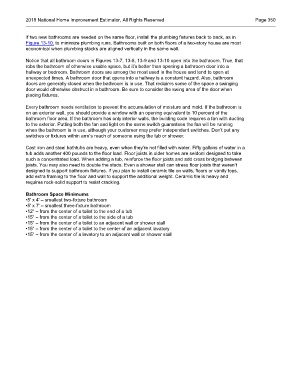Page 437 - 2018 National Home Improvement
P. 437
2018 National Home Improvement Estimator, All Rights Reserved Page 350
If two new bathrooms are needed on the same floor, install the plumbing fixtures back to back, as in
Figure 13-10, to minimize plumbing runs. Bathrooms built on both floors of a two-story house are most
economical when plumbing stacks are aligned vertically in the same wall.
Notice that all bathroom doors in Figures 13-7, 13-8, 13-9 and 13-10 open into the bathroom. True, that
robs the bathroom of otherwise usable space, but it’s better than opening a bathroom door into a
hallway or bedroom. Bathroom doors are among the most used in the house and tend to open at
unexpected times. A bathroom door that opens into a hallway is a constant hazard. Also, bathroom
doors are generally closed when the bathroom is in use. That reclaims some of the space a swinging
door would otherwise obstruct in a bathroom. Be sure to consider the swing area of the door when
placing fixtures.
Every bathroom needs ventilation to prevent the accumulation of moisture and mold. If the bathroom is
on an exterior wall, you should provide a window with an opening equivalent to 10 percent of the
bathroom floor area. If the bathroom has only interior walls, the building code requires a fan with ducting
to the exterior. Putting both the fan and light on the same switch guarantees the fan will be running
when the bathroom is in use, although your customer may prefer independent switches. Don’t put any
switches or fixtures within arm’s reach of someone using the tub or shower.
Cast iron and steel bathtubs are heavy, even when they’re not filled with water. Fifty gallons of water in a
tub adds another 400 pounds to the floor load. Floor joists in older homes are seldom designed to take
such a concentrated load. When adding a tub, reinforce the floor joists and add cross bridging between
joists. You may also need to double the studs. Even a shower stall can stress floor joists that weren’t
designed to support bathroom fixtures. If you plan to install ceramic tile on walls, floors or vanity tops,
add extra framing to the floor and wall to support the additional weight. Ceramic tile is heavy and
requires rock-solid support to resist cracking.
Bathroom Space Minimums
•5' x 4' – smallest two-fixture bathroom
•5' x 7' – smallest three-fixture bathroom
•12" – from the center of a toilet to the end of a tub
•15" – from the center of a toilet to the side of a tub
•15" – from the center of a toilet to an adjacent wall or shower stall
•15" – from the center of a toilet to the center of an adjacent lavatory
•15" – from the center of a lavatory to an adjacent wall or shower stall

